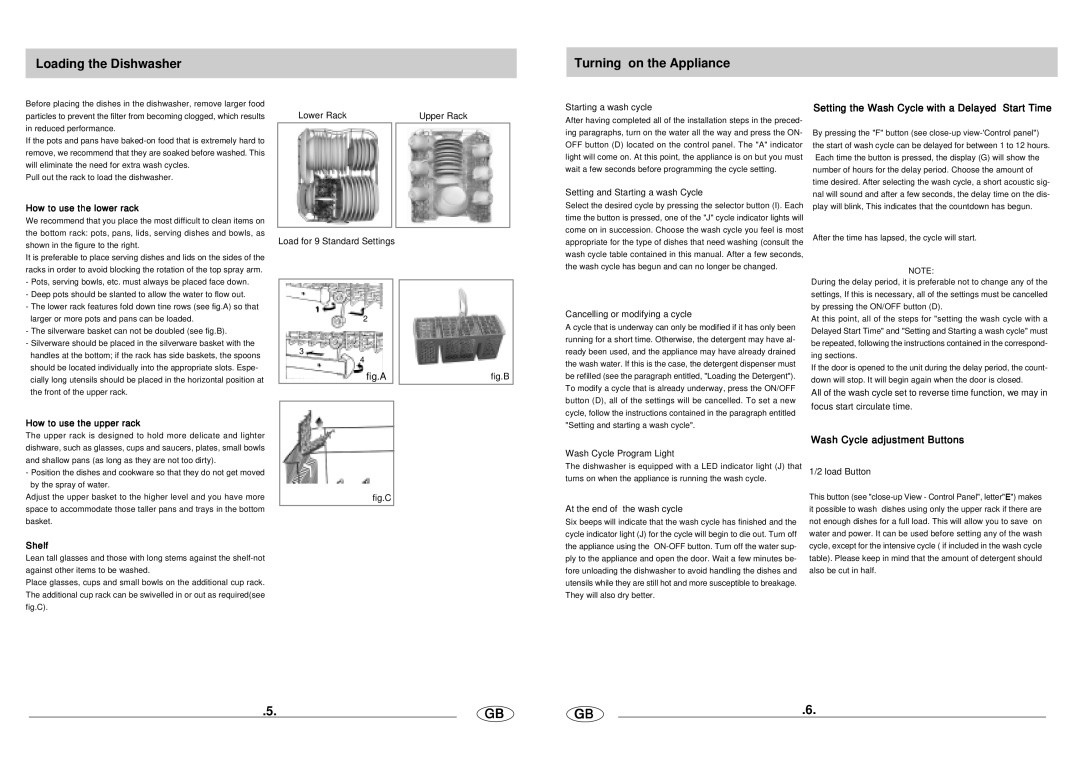
Loading the Dishwasher
Turning on the Appliance
Before placing the dishes in the dishwasher, remove larger food
particles to prevent the filter from becoming clogged, which results Lower Rack in reduced performance.
If the pots and pans have
Pull out the rack to load the dishwasher.
Upper Rack
Starting a wash cycle
After having completed all of the installation steps in the preced- ing paragraphs, turn on the water all the way and press the ON- OFF button (D) located on the control panel. The "A" indicator light will come on. At this point, the appliance is on but you must wait a few seconds before programming the cycle setting.
Setting and Starting a wash Cycle
Setting the Wash Cycle with a Delayed Start Time
By pressing the "F" button (see
How to use the lower rack
We recommend that you place the most difficult to clean items on the bottom rack: pots, pans, lids, serving dishes and bowls, as shown in the figure to the right.
It is preferable to place serving dishes and lids on the sides of the racks in order to avoid blocking the rotation of the top spray arm.
-Pots, serving bowls, etc. must always be placed face down.
-Deep pots should be slanted to allow the water to flow out.
-The lower rack features fold down tine rows (see fig.A) so that larger or more pots and pans can be loaded.
-The silverware basket can not be doubled (see fig.B).
-Silverware should be placed in the silverware basket with the handles at the bottom; if the rack has side baskets, the spoons should be located individually into the appropriate slots. Espe- cially long utensils should be placed in the horizontal position at the front of the upper rack.
How to use the upper rack
Load for 9 Standard Settings
1
2
3
4
fig.A
fig.B
Select the desired cycle by pressing the selector button (I). Each time the button is pressed, one of the "J" cycle indicator lights will come on in succession. Choose the wash cycle you feel is most appropriate for the type of dishes that need washing (consult the wash cycle table contained in this manual. After a few seconds, the wash cycle has begun and can no longer be changed.
Cancelling or modifying a cycle
A cycle that is underway can only be modified if it has only been running for a short time. Otherwise, the detergent may have al- ready been used, and the appliance may have already drained the wash water. If this is the case, the detergent dispenser must be refilled (see the paragraph entitled, "Loading the Detergent"). To modify a cycle that is already underway, press the ON/OFF button (D), all of the settings will be cancelled. To set a new cycle, follow the instructions contained in the paragraph entitled "Setting and starting a wash cycle".
play will blink, This indicates that the countdown has begun.
After the time has lapsed, the cycle will start.
NOTE:
During the delay period, it is preferable not to change any of the settings, If this is necessary, all of the settings must be cancelled by pressing the ON/OFF button (D).
At this point, all of the steps for "setting the wash cycle with a Delayed Start Time" and "Setting and Starting a wash cycle" must be repeated, following the instructions contained in the correspond- ing sections.
If the door is opened to the unit during the delay period, the count- down will stop. It will begin again when the door is closed.
All of the wash cycle set to reverse time function, we may in
focus start circulate time.
The upper rack is designed to hold more delicate and lighter dishware, such as glasses, cups and saucers, plates, small bowls and shallow pans (as long as they are not too dirty).
-Position the dishes and cookware so that they do not get moved by the spray of water.
Adjust the upper basket to the higher level and you have more space to accommodate those taller pans and trays in the bottom basket.
Shelf
Lean tall glasses and those with long stems against the
Place glasses, cups and small bowls on the additional cup rack. The additional cup rack can be swivelled in or out as required(see fig.C).
fig.C
Wash Cycle Program Light
The dishwasher is equipped with a LED indicator light (J) that turns on when the appliance is running the wash cycle.
At the end of the wash cycle
Six beeps will indicate that the wash cycle has finished and the cycle indicator light (J) for the cycle will begin to die out. Turn off the appliance using the
Wash Cycle adjustment Buttons
1/2 load Button
This button (see
.5. | GB | GB | .6. |
